Mid Atlantic Islands
Things to DO
St Helena
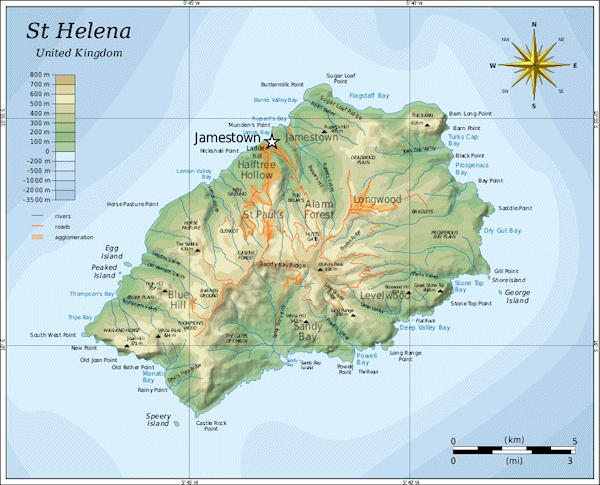
St. Helena is a British Overseas Territory and one of the last relics of the colonies. The island
has a Governor and the upper echelons of the administration mostly are expatriate British. The islanders are
represented by an elected Executive Council (EXCO) and Legislative Council (LEGCO) although these bodies have
little real influence on the running of the island.
The population of St. Helena is approximately 6,000. The main centres of population are Jamestown
(the capital), Half Tree Hollow, and Longwood.
Ascension Island and the Falklands provide employment for a large number of Saints. There is a large Saint
population in the UK and a substantial St. Helenian community settled in South Africa.
St. Helena's main income is from the export of fish. St. Helena coffee is of very high quality but the
production is quite small.
Tourism operates on only a very limited scale.
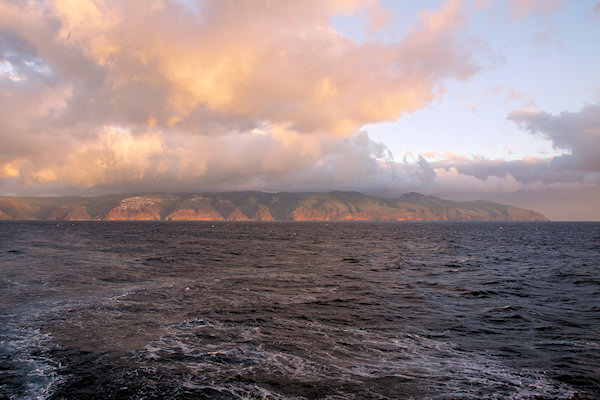 |
|||||
The climate of St. Helena is strongly influenced by the southeast trade winds. The coastal areas are
drier and hotter than the interior; in Jamestown the temperature ranges from 14°C to 32°C with an average
annual rainfall of 152 mm; whereas in the central hills the temperature ranges from 8°C to 26°C and
the average annual rainfall is
as much as 1 m.
St. Helena has some stunning scenery.
The coastline of the island comprises high vertical cliffs cut by steep-sided v-shaped valleys. The coastal
areas are rugged and barren whereas the higher elevations in the centre of the island have lush vegetation.
A good network of (albeit narrow, winding, and steep) roads makes much of the island reasonably accessible.
However, the best of St. Helena is seen on foot; there are some magnificent walks and hikes to be had on
the island.
Jamestown
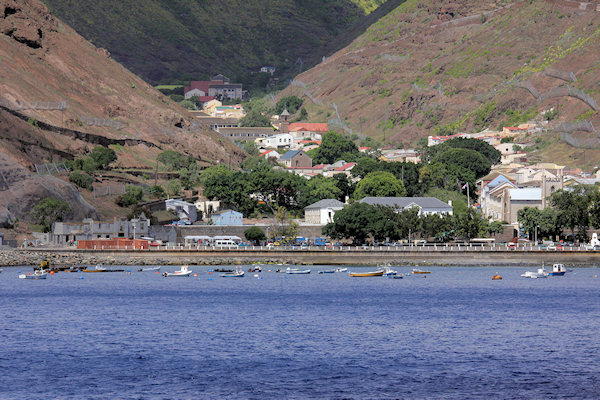 |
|||||
Jamestown was founded in 1659 by the English East India Company and named after James, Duke of
York, the future King James II of England.
Entering town, you encounter the Town Gate and the towns inner wall. Until 1935, the town moat was
crossed using a drawbridge. Looking up just before you walk through the town gate, you can see the coat of
arms of the last govener of the east India Company, Charles Dallas, who held the office from 1829
until 1836.
The large area you encounter after passing through the town gate, is called the Grand Parade. This
was used in earlier years as the drill ground for the British Garrison.
On the left side, you can see the entrence to the government offices building, the Castle. The building
complex next to this was built at the beginning of the 19th century and contains the Police Headquaters,
the Court Building and the Public Library
The church here is St James' Church, completed in 1774. it is located in the area where the Portugese
erected the first chapel on the island in the 16th century.
On the right side of the square you can see Jacob's Ladder, completed in 1829, with it 699 steps
leading op to Ladder Hill. To the side of the steps there were once tramways, operated by simple
machinery worked by a capstan bar and ropes by mules at the top.
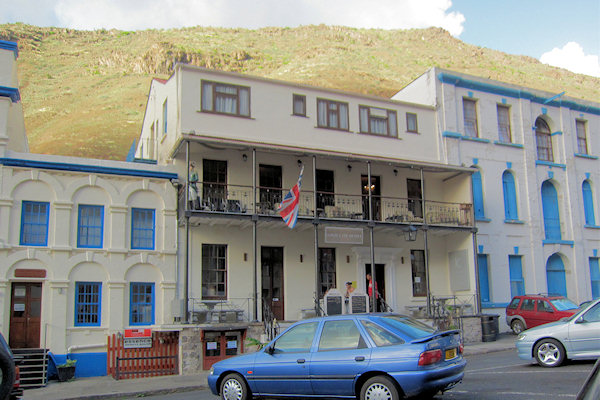 |
|||||
They were used to tansport ammunition and supplies to themilitary base, which was on top off Ladder
Hill.
Leaving the Grand Parade and walking towards the centre of town, we find ourselfves on Main Street.
On the left we pass the Castle Gardens, originally the garden of the East India Company.
The long building which is situated across the end of Main street, houses the Tourist Office
The two large trees in front are Peepul trees, which are sacred in India. In earlier years, these
trees were planted the whole length opf Main street. Before the abolition of slavery in 1832, the slave
market was held at this spot.
Walking to the right of the tourist information building and stopping at the end of the street, You come
upon another square, called The Bridge. The cast-iron and wrough-iron building, which dominates the
right side of the street, is called the Market and serves as the market hall. It was prefabricated
in England in 1865 and the individual pieces were shipped to St Helena, where is was assembled. This type
of construction was chosen because of the termite invasion. (In the 1860's termites had done
significant damage to many buildings on the island.)
The clock tower in front was constructed in 1930.
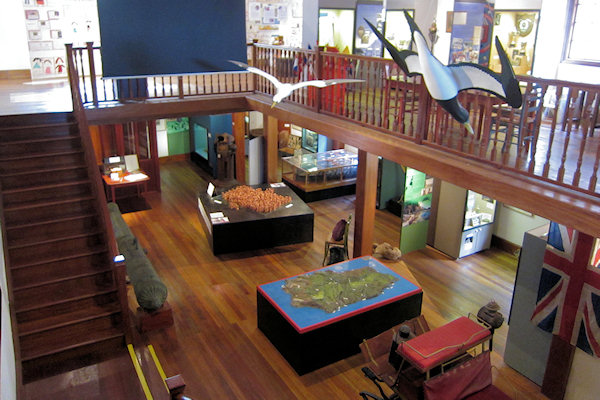 |
|||||
The St Helena Heritage Society, founded in 1980, maintains a splendid new museum at the foot of
Jacob's Ladder. With a lot of work and fundraising, the Friends of St Helena and the Heritage Society
have converted the Old Power House and it was opened to coincide with the quincentenary celebrations
in may 2002.
The museum tries to preserve the island's history and present it to the island's visitors. It holds a number
of interesting artefacts from St Helena's past including old coins, Ming porcelain, photographs, items made
by the Boer War prisoners, items recovered from the sunken Witte Leeuw, old rifles and pistols,
musical and scientific instruments, bottles, old radios and jars etc.
The museum has also acquired a number of objects directly related to
St Helena's past and present, given by local and overseas donors. It also has collected extensive reference
material and has developed into an important resource for the island.
As well as permenet displays, there are a number of special exhibitions and and it runs a useful Museum for
Everyone initiative which aims to invilve as many islanders as possible in the museum
There is a small but interesting range of items for sale.
Napoleon Bonaparte
After Napoleon's defeat at The Battle of Waterloo (18 June 1815), Napoleon formally demanded
political asylum from the British Captain Frederick Maitland. The British choosed to exile him to
the island of Saint Helena in the Atlantic Ocean, 1.870 km from the west coast of Africa.
Upon arrival at St Helena, Napoleon scrutinised his island prison with the same spy glasses he used on
many battlefields, and is reputed to have said "It is not an attractive place; I should have done better
to remain in Egypt"
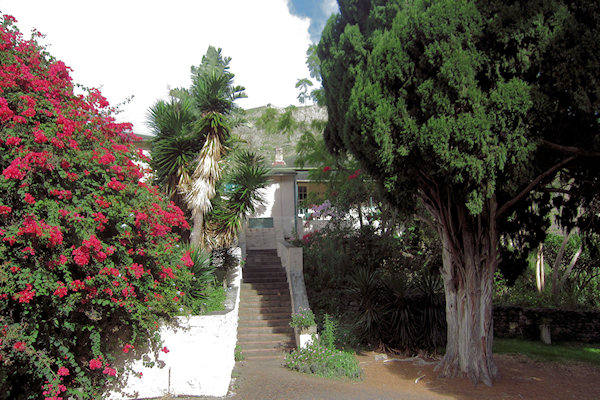 |
|||||
Briars is the name of the small pavilion in which Napoleon Bonaparte stayed for the first few weeks
of his captivity on Saint Helena. The pavilion was in the garden of William Balcombe, an English
merchant who became a purveyor to Napoleon. His 14 year old daughter Elizabeth Lucia ("Betsy") was the only
family member who spoke French and she became the family translator.
Because of his and his family's closeness to Napoleon, Balcombe attracted the suspicion of Governor Hudson
Lowe, and in 1818 he decided to leave the island and return to England.
In 1959 the Pavilion was offered to the French Government by a descendant of William Balcombe, Mabel
Brookes.
Longwood House was the residence of Napoleon I, until his death on 5 May 1821. It is situated on
a windswept plain some 4 miles (6 km) from Jamestown. Formerly the summer residence of the Lieutenant
Governor, it was converted for the use of Napoleon in 1815.
In February 1818, Governor sir Hudson Lowe proposed to Lord Bathurst (Secretary of State for War
and the Colonies) to move Napoleon to Rosemary Hall, a house that became available and was located in a
more hospitable part of the island, sheltered from the winds and shadowy, as Napoleon had preferred.
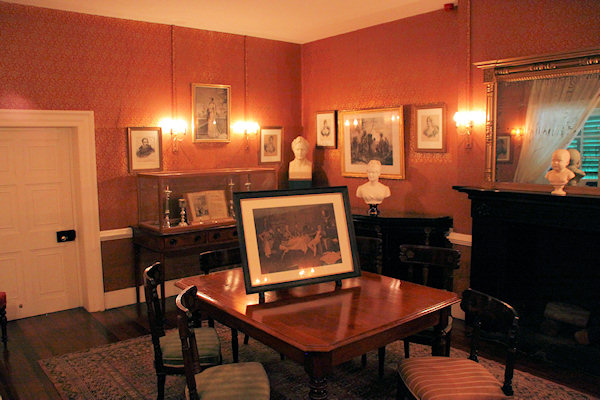 |
|||||
But the recent revelations of General Gourgaud in London (about Napoleons attemp to escape)
brought Lord Bathurst to the opinion that it was safer to keep Napoleon at Longwood, where an escape was
harder to undertake. After Napoleon's death, Longwood House reverted to the East India Company and later to
the Crown, and was used for agricultural purposes. Reports of its neglect reached Napoleon III, who from
1854 negotiated with the British Government for its transfer to France. In 1858 it was transferred to the
French Government
The Emperor chose Sane Valley for his own burial site. He hiked into Sane Valley on one of his walks and was
delighted with the peaceful landscape and attractive plants that grew there. He was indeed buried in this
Valley of the Tomb. But as we know, but Napoleon didn’t know, his body was later (in 1840) exhumed
and returned to Paris. In 1858 the Valley of Tomb was transferred to the French Government.
Ascension Island
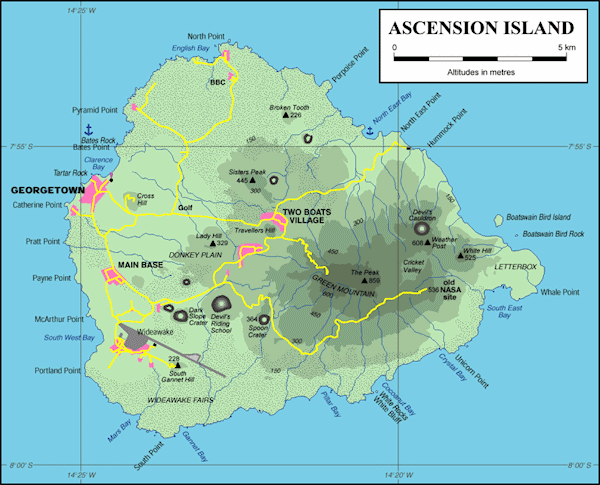
Ascension is a rocky peak of purely volcanic origin. It is located 1.100km nortwest of St Helena. Geologically Ascension is very young and the possibility of volcanic activity can never be completely ruled out. There are 44 dormant craters on the island. Much of the island is covered by basalt lava flows and cinder cones, giving the impression of a moonscape. The last major volcano eruption took place arounfd 600 years ago. The highest point on the island is Green Mountain (861m), covered with lush vagetation which increaingly spreads throughout the island during rainy season. The small farm near the peak once produced vegetables, but has unfortunately fallen into disrepair.
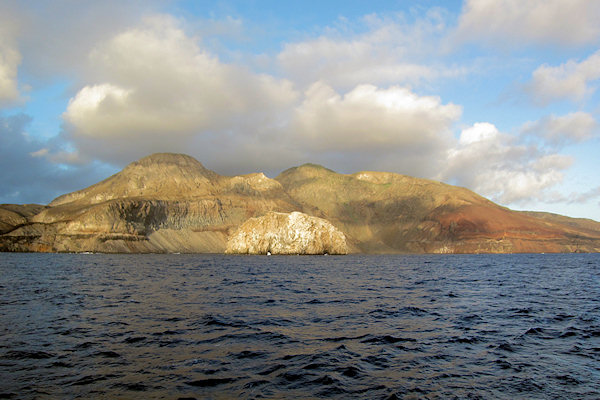 |
|||||
In 1899, the Eastern Telegraph Company installed the first underwater cable from the island,
connecting the UK with its colonies in South Africa.
During World War II, the United States built an airbase on Ascension Island, known as "Wideawake".
The Airfield was used as a stopping point for American aircraft crossing the Atlantic Ocean on the way to
theatres of operation in Europe and Africa. After the end of World War II, and American departure, the
airbase fell into disuse.
With the Space Race and the Cold War, the Americans returned in 1956. Wideawake Airfield was expanded in
the mid 1960s. The runway, with its strange hump, was extended, widened, and improved to allow its use by
large aircraft, and later to act as an emergency runway for the Space Shuttle.
NASA established a tracking station on the island in 1967, which it operated for more than 20 years
before closing it down in 1990. The island retains a role in Space exploration as the European Space
Agency now operates an Ariane monitoring facility there.
In 1982 a British task force used Ascension Island as a staging post during the Falklands War.
Following the war, the British retained an increased presence on the island, establishing RAF Ascension
Island, and providing a refuelling stop for the regular airlink between RAF Brize Norton in Oxfordshire, and
RAF Mount Pleasant in the Falkland Islands.
Georgetown
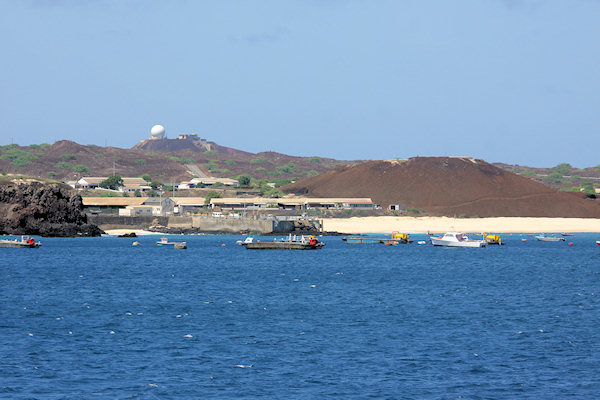 |
|||||
The capital of Ascension is Georgetown. It is more a small village with a few shops than a
grand capital. There is a hotel, questhouse and some bungalows.
The Exiles was constructed in 1830 as a single Marine Barracks. In 1848 a second storey was
added bringing the capacity of the barracks to 150.
A clock was provided as an alternative to the firing of a gun every hour to mark the time. it used to be
said that time passes so slowly for the marines on Ascension that the clock chimmed "Oh Gawd" every
quater of an hour.
With the withdrawl of the navy, the building became the Ascension Club
The only church in Georgetown is St Mary's, an Anglican church witch was completed in 1847.
The building was modernised in 1879/80, a chanchel was added and the altar placed on its present pltaform.
Electric light was installed in 1924 and, also in that year, the first choir was informed. It serves 24 hours
a day for private prayer. The door is only closed to prefent sheep or donkeys from entering.
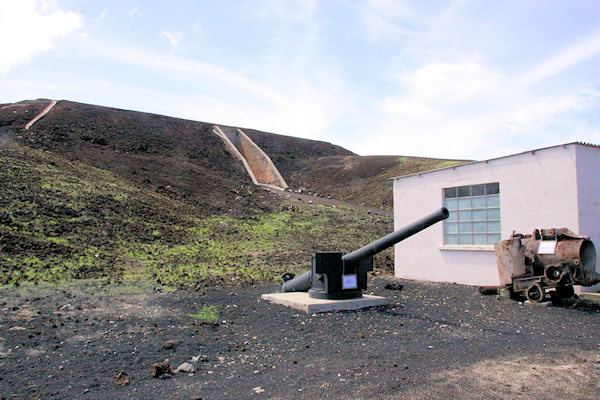 |
|||||
Fort Hayes was constructed on Goat Hill in the 1860's. The fort was a major defence, and
by the start of WWI, mounted one six-inch gun and two 4.7-inch guns and was garrisoned by 38 men. The
building at the base of the fort is the reserve magazine, which was designed as a temporary hospital in
times of war.
The fort is now part of the Ascension Heritage Society, which runs a museum inside.
The new buildings opposite the ford, opened in 1994, houses the Islander newspaper.
The Gallery, also part of the historical heritage, is manned by a knowledgeable team of volunteers
who will be happy to show you around.
Natural History and Conservation
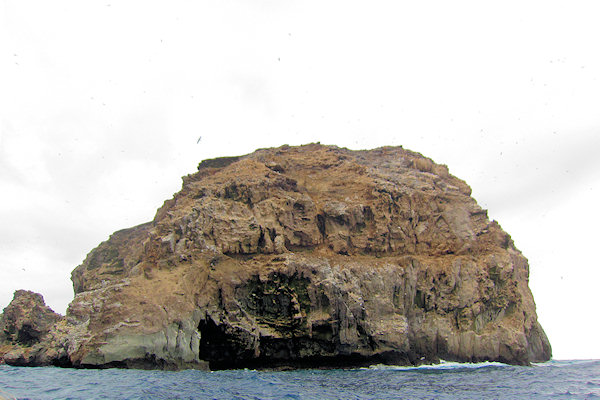 |
|||||
Before the 19th century, Ascension Island had no mammals and a few plants. It was however, home to one
of the largest seabird colonies in the tropical Atlantic with up to 20 million boobies, terns and
frigatebirds nesting there.
The introduction of feral cats in 1815 has cleared the majority of the birds. Another main reason for the
drastic decline in seabirds on Ascension was the arrival of man who harvested birds and their eggs
and mined some of the guano.
The Ascension seabird restoration Project has since 2001, removed feral cats from ascension Island
and since february 2004, no feral cat have been seen on the island, encouraging the promt return of the
seabirds.
Boatswain Bird Island, a small rock off the east coast of Ascension Island is the main birdingspot. It
houses about 400.000 seabirds of 11 species.
Amongst the species are Ascension Island frigatebird,
Brown and Black Noddy's, White-tailed Tropicbird, Fairy Tern and
Red-footed Booby's.
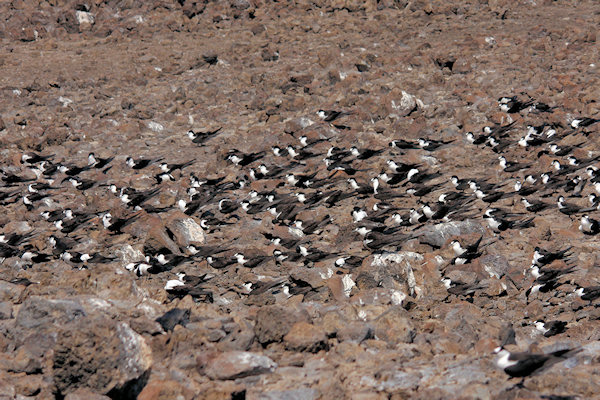 |
|||||
On the mainland, at the soutwest coast, called the Wideawake Fairs, there is a colony of about
200.000 pairs of Sooty Terns.
One of the most renowned attraction of Ascension are the Green Sea Turtles. Many tourists flock to
the beach after dark during egg-laying season, january to may, to observe the turtles laying their eggs on
the beach and returning to the ocean.
As long as anyone can remeber, these creatures have migrated to the island annually from their feeding
grounds along the South American coast.
There is a colony of land crabs that lives on the island. Within the species, two distinct colour
morphs can be seen. The "yellow" morph has a bright yellow or orange exoskeleton, with white
patches on the underside of the walking legs and claws. The "purple" morph has a dark purple
exoskeleton, but with the same white patches as on the yellow morph.